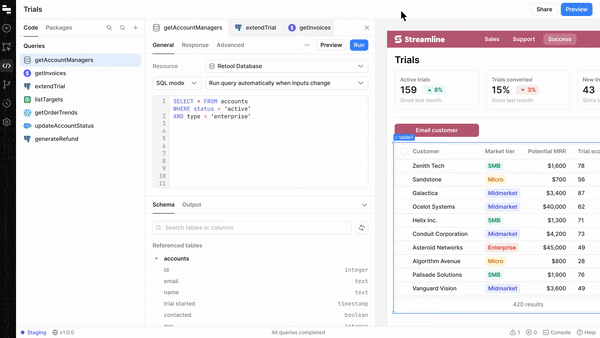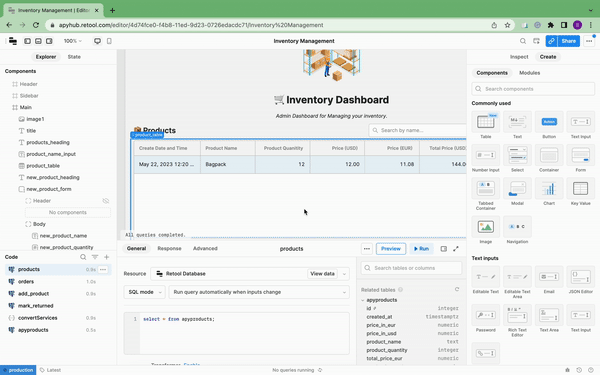
In today’s fast-paced business world, operational optimization, higher output, and better user experiences are more important than ever. Businesses know how important it is to make internal tools unique to their needs to deal with these issues head-on.
Over the years, this project has needed a lot of time, money, resources, and special knowledge. This has often caused the development process to take longer and cost more. But everything has changed since low-code systems like Retool came out. Companies can cut costs, speed up development, and give their teams the tools to make complicated internal tools quickly and easily with these platforms.
Platforms with simple interfaces and ready-made parts, like Retool’s, can help businesses get to operational success faster. In a market that is getting more competitive, this helps them stay small and quick to act.
What is Retool?
Established in 2017 in San Francisco, California, Retool is a low-code platform changing how companies make their custom tools. Software engineering teams and leaders worldwide quickly adopted Retool because it makes custom admin panels, database frontends, APIs, and customer support screens easier. Retool is a great partner for businesses that want to improve their processes and reduce development costs because it makes custom internal tools faster and easier.
Why Retool Is So Popular?
The flexibility and easy-to-use interface of Retool made it very popular. It lets users quickly create internal tools without needing to know a lot about coding. Along with its quick deployment options, its ability to work seamlessly with many databases and APIs made it appealing to both coders and non-developers.
Its collaborative features also helped teams work better together, which made it a top choice for companies that want to streamline their processes and shorten the time it takes to create new products.
How Does Retool Work?

The drag-and-drop application builder with Retool is very easy to use and is the core of its features. This builder comes with a wide range of pre-built components that make it easier to make front ends for custom internal tools. Users can easily drag these parts onto a board and change them to fit their needs. This easy-to-understand process lets anyone, even those who could be better at writing, make interfaces that work and look good.
In the background, Retool’s integration library is a key part of smoothly connecting these front-end parts to different data sources. Because Retool makes it easy, coders can easily connect to databases, internal APIs, or SaaS products. In this way, the platform allows users to fill their user interfaces with data from different sources, making the unique internal tools being built more useful and functional.
One important thing that makes Retool stand out is that it can hide the hard parts of making and handling custom software. Another way that Git update speeds up development is by making it easier to work with your team and keep track of code changes.
One more thing that Retool does well is offer business-level tools such as Single Sign-On (SSO), audit logging, and dedicated support. These features make it possible for groups of all sizes and types to get the materials and tools they need for their own development projects. It stands out because of how well it combines front-end design, data connectivity, and infrastructure control.
How Retool Saves Time and Money?
What’s great about Retool’s new low-code approach to custom internal tool creation is that it makes things easier and saves companies time and money. In what way does Retool do this? Let’s learn more:
Better and faster development
Drag-and-drop and a large library of pre-built components in Retool help firms speed up the development process. When builders use Retool’s simple tools to make their tools quickly, they don’t have to start from scratch. This makes complex apps go much faster. You can now drag and drop parts onto a surface and change them as needed. Companies can quickly implement solutions to meet urgent business needs because the development cycle is shorter. In the market, this gives them an edge.
Building those costs less
Most of the time, you have to pay professionals a lot to build the front end, back end, and infrastructure. It would help if you grew many things, but retooling eliminates many. The low-code platform from Retool lets companies give their present employees the tools they need to make complex internal tools. This way, they don’t have to hire costly skilled engineers. This saves money on hiring and training ensures that the work stays cheap as the project goes on and provides a competitive advantage, speed.
More efficient running of businesses
Making custom private tools with Retool that can do the work of email or spreadsheets can help businesses run more smoothly. Businesses can get more done and work more efficiently by putting these jobs in one place, automating them on a single platform, and freeing up time and resources for bigger, more important projects by automating chores that used to need human help. Automating jobs like data entry, workflow management, and report-making is possible with Retool. This helps businesses run better and make all of their teams more productive.
More adaptability and ease of access
One great thing about Retool is that it can let everyone in the company build and use tools. More people, like server engineers, data engineers, product managers, and business analysts, can build and use their internal tools with Retool. This differs from the old methods of development, which require people with certain skills. With more freedom and access, teams across the business can collaborate better and quickly develop new ideas. Retool lowers the barriers to entry to bring about new ideas and gives teams the power to make changes in their respective work environment.
Support and upkeep are now easier
Internal tools that are hard to support and maintain can be hard to hide. Retool hides those parts and gives businesses strong tools to do the job well. With Retool, groups don’t have to worry about how to run the server; they can focus on using their tools.
Large businesses can use it, and it has version control and fine-grained powers. Making maintenance and changes easier and faster lets people do what they do best, which is add value to the business. Businesses can also get support from Retool in several different ways, which gives them peace of mind and lets them call for help whenever they need it.
Finally, the low-code way that Retool lets companies make their custom tools is a huge step forward for those who want to do better work, save time and money, and become more efficient. When you use Retool, you speed up the development process, lower costs, make things easier to reach and more flexible, and make support and maintenance easier. This helps companies develop new ideas and do well in today’s fast-paced business world.
Pros and Cons of Retool
Pros of Retool
Retool is great for making custom internal tools and changing how groups make and use them in many ways. Let’s talk about these pros in more detail:
Develop front ends without the right knowledge
It’s simple to make front ends for custom internal tools with Retool’s drag-and-drop creator, even if you need to improve writing code. People can start making tools faster with this feature by dragging pre-built parts onto a surface and changing them to fit their needs. It’s faster to work on the front end with Retool because users don’t need to know much about code. This speeds up research and lowers the cost.
Retool’s simple design also makes it easy for teams with and without technical knowledge to work together, letting people from different departments work together on making tools. Everyone in the company can now do front-end coding. This lets people help make tools that are useful and meet their needs.
Use any database or API to connect

There are a lot of connections in Retool that make it easy to connect to almost any database or API. This allows workers to access and use data from different parts of the business. This makes processes more efficient by bringing together information from different sources.
Limiting who can get to a level
It puts security and control first by allowing Role-Based Access Controls (RBAC) immediately. Firms can create and apply fine-grained access control rules with this feature, ensuring users have the right permissions for their tasks and jobs.
RBAC helps businesses lower their security risks and keep private info safe from people who shouldn’t be able to see it. Administrators can give users different roles and rights, which gives them tight control over who can see, use, and modify internal tools with their features. This fine-grained access control method makes things safer and helps people follow the rules that the business and the government set.
Quick creation and keeping track of updated versions
Retool’s drag-and-drop interface makes it easy to make special internal tools quickly and speeds up the development process. Developers can quickly make and use front-end components with Retool’s big library of pre-built elements.
Version control is also possible with Retool through Git syncing. This ensures that app changes are handled, tracked, and recorded correctly. It’s easier for teams to work on projects together now that they can connect to version control systems and not have to think about code disagreements or mistakes.
Make custom business tasks run themselves
Retool’s Workflow feature allows businesses to handle complicated business processes without using people. This makes things run more smoothly. The Workflow feature in Retool gives you the flexibility and freedom to handle custom logic well, whether setting up data processes, scheduling tasks that run over and over, or acting when certain events happen.
Businesses can be more productive, make fewer mistakes, and free up important resources to work on bigger projects by automating routine tasks and processes. With Retool’s Workflow feature, businesses can make automation solutions that are flexible and easy to manage. These solutions help improve operations and speed up business growth.
Cons of Retool
For custom internal tool creation, Retool has a lot of benefits, but it’s important to know what its problems and limitations are. Knowing about these things helps groups make smart choices and lessen the effects of any problems.
Limited Ability to Add on with Code
The best thing about Retool is its low-code way, which lets people make powerful tools even if they don’t know much about coding. JavaScript lets you change how Retool works, but coders who need to change more complex things or add support for other languages might need help. This could mean you can’t add or use complicated features or functions, which could deter people from doing what they need to do
Poor performance
It might be necessary to fix Retool, especially when working with big files or tough processes. This is yet another big fear. Because they only do one search at a time and run code in the browser, Retool apps might need to be fixed. This might make the person feel hesitant and slow them down. Some businesses may be unable to use Retool because it is too slow for them to handle or process large amounts of data quickly. It would be very important for these groups to plan how to use and handle their resources carefully.
Unable to stream
It’s a big problem for businesses needing real-time data, and Retool only works with streaming systems like Kafka or Kinesis. Streaming technologies make it possible to process and examine data streams in real time. This lets us move quickly and gain new insights. Businesses might only be able to get the most out of their data if it has built-in support for streaming. They may have to use other methods or find other ways to get around problems, making how they handle data more difficult and less effective.
Uncommonly observable
It’s harder for developers to keep an eye on and fix app bugs because Retool needs direct integrations with observability tools. An observability tool offers a centralized platform to aggregate and visualize telemetry data gathered from application and infrastructure components within a distributed environment. You can get real-time information about how a program works, find mistakes, and fix problems with the help of observability tools like AppDynamics, Datadog, Dynatrace, Grafana, etc. Developers may not quickly find and fix problems if they can’t connect to observability tools without any issues. This could lead to more downtime and affect how the business runs.
Retool has many great features and benefits for custom internal tools, but companies must know its limitations. There are many issues with Retool that businesses need to consider if they want to use it. Some examples include the inability to use the customized code, slow performance, and the high costs of self-hosting. For organizations to get the most out of Retool with the least number of problems, they need to be aware of these issues and take steps to fix them through careful planning, optimization, and smart decisions.
Who uses Retool?
Retool is being used by many professionals, here is how this tool is helping them:
Data Engineers
Other tech and business intelligence teams can use the data that data engineers handle and move from different sources. Retool’s drag-and-drop app builder lets them make full-stack apps without dealing with user rights, authentication, permission, or any other tricky parts of making apps.
Backend Engineers
Retool has a lot of pre-built front-end components that engineers can use to make flexible apps, even if they need to learn more about front-end development. This lets backend developers add front-ends to APIs or services they already have.
Product Managers
To make full-stack apps from scratch, a product manager might need to learn how to use React, even if they know how to write simple JavaScript and SQL searches. Professional managers can make apps that report on database, log, and analytics tool usage with Retool. These apps also allow you to handle things like tickets and feature requests.
Business Analysts
Some people, like business experts, need to see and work with data, but they must improve at writing code. They don’t have to use spreadsheets or other BI tools because their apps with Retool are more powerful, flexible, and fun.
Conclusion
In conclusion, Retool is a strong tool that helps businesses make custom internal tools more efficiently by cutting costs and improving operational efficiency. With its low-code platform, easy-to-use interface, and wide range of interfaces, retool lets teams make useful tools without knowing much about coding. While the platform does have some flaws, its total value makes it a strong contender for companies that want to transform their internal tooling infrastructure in today’s competitive business world.



